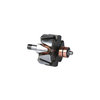Michael Noel
Filing Flight Plan
- Joined
- May 10, 2022
- Messages
- 7
- Display Name
Display name:
Caballo
The Chrysler alternator on my Archer is no longer working and I'm trying to understand the failure mode. I checked the brush and it still has over 1/4 inch of material. The brush has good force against the slip ring. After cleaning the slip ring with q tips and contact cleaner while rotating the prop through multiple rotations, the measured resistance through the brush to aircraft ground is abought 8 ohms through half of a rotation of the alternator and into the K ohms through the other half rotation. Does this difference in resistance on half a rotation point to a particular type of alternator failure?





